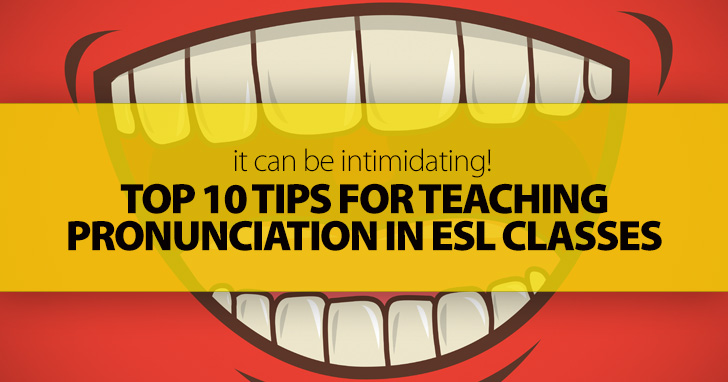Top 10 Tips for Teaching Pronunciation in ESL classes


Of course you would. Every teacher wants to see his or her students succeed, and it’s no different for those of us who teach speakers of English as a second language. So what is this super trick that can help your students succeed in a way you might never have thought possible? That can help them achieve better pronunciation than they have ever had before? And can even improve their ability to listen and distinguish what they hear? Read on to find out.

I’ll be upfront with you. The secret to your students’ pronunciation success is no secret at all. It’s the phonetic alphabet. But don’t click to another page yet. If you aren’t already using the phonetic alphabet in class, I can already guess your objections. It’s too complicated. It won’t help my students. That’s just for linguists. Well, I can honestly tell you that those things are not true, and so can any other ESL teacher who has seen the value and ease of using the phonetic alphabet with his or her ESL class!
It’s not complicated. Really, it isn’t. The phonetic alphabet is a one to one correspondence between symbols and sounds. Most of the symbols are English letters to begin with. You know what sound “t” makes, so you already know what sound [t] represents. It’s just a different type of notation. Is writing [I] really more complicated than saying “short I”? No. I’d even wager that if you know nothing whatsoever about the phonetic alphabet, you can still correctly pronounce this phonetic notation: [pIg].
To be completely honest, not every sound is represented by one English letter, and there are a few matchups that may seem unintuitive. [i] sounds like “ee” in sheep. [u] sounds like “oo” in boot. But for the most part, the phonetic symbols are logical and familiar representations of the sounds in English as well as any other language. If you take just a few minutes to learn the symbols (perhaps as you teach them to your students) using them will become second nature as you teach. And then you can take advantage of all the phonetic alphabet has to offer.
Let me get a little scientific for a moment. All hearing babies are born with the ability to distinguish all the different sounds that make up all the languages of the world (with the exception of tone, which is a learned skill). By the time a baby has reached her first birthday, her she has learned the sounds that make up her native language and has lost the innate ability to distinguish sounds that are not in the language she hears around her. This means that by the time your students enter your classroom, they may have lost the ability to hear and therefore distinguish between certain sounds. (Think r and l for native Japanese speakers, long and short I for native Spanish speakers, etc.) In order to help them achieve perfect English pronunciation, you will have to reeducate your students to distinguish between all the different sounds in the English language, and that is where the phonetic alphabet comes into play.
Some students are able to learn these different sounds without a lot of struggle, but that’s not the case for all of your students. Others will struggle and struggle to the point of giving up when they just can’t hear the difference in the sounds of some English words. You can help these struggling students by using the phonetic alphabet. We all know that English spelling is less than perfect, to say the least. Since the phonetic alphabet is completely based on sound, showing your students how to transcribe a word (one whose pronunciation they struggle with) can turn on the light bulb of understanding. When they see the sounds in the word, they can begin to hear the sounds in the word as well.
The natural result of hearing words better is pronouncing them better. A person must know what they are supposed to say before they can say it, and hearing correct pronunciation is the first step on that road. Sometimes, though, a student may think her pronunciation is correct only to be told by you what she is saying is mispronounced. But she can’t hear the mistake in what she is saying. What do you do? Transcribe for her what she is saying. Then transcribe for her what she should be saying, and you do that using the phonetic alphabet. When a student can see these two versions of a word’s pronunciation side by side, she can see and then hear her mistake and can then begin to achieve perfect pronunciation. And if you have already taught your students the sounds in the phonetic alphabet and they can pronounce them, she should be able to correctly pronounce the entire word that you transcribe for her even if she couldn’t correctly pronounce it from the spelling alone.
The benefits of learning and teaching the phonetic alphabet aren’t just for your students. Granted they will be the biggest beneficiaries of bringing it into class, but you will benefit, too. You will become a better teacher. How, you ask? Because you will become more aware of your own pronunciation. We all know that pronunciation varies from one region of the U.S. to another, from America to the U.K. and to all the countries where each of you is teaching English. By phonetically transcribing what you are saying and seeing the phonetic representation of that word (ask a native speaker if you aren’t sure about your own pronunciation) you will become more aware of your own personal and regional accent. Having an accent doesn’t mean you aren’t a good speaker of English. Everyone has one. Even the most neutral of English pronunciations (newscaster-ese) has variations from one person to another. If you can become aware of your own deviations from standard pronunciation and share those with your students, they will be better able to understand someone who speaks with a different accent. That’s because they will know the standard pronunciation because you wrote it with the phonetic alphabet in class even if you don’t’ normally say the word that way.
With such great benefits to offer and such little work to learn, using the phonetic alphabet in your class can make a huge difference with how well your students speak and listen in the English language.